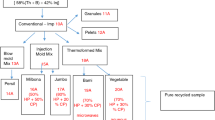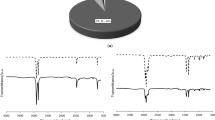Abstract
The aim of the present work is to study plaster residues produced in industries in Goiás State (Brazil). The study analyzes the trituration and dehydrating processes of the plaster and compares its chemical, mechanical and physical characteristics to the natural plaster samples aiming its possible recycling.
Plaster samples were submitted to X-ray diffraction, infrared spectroscopy, thermogravimetric (TG) and differential scanning calorimetry (DSC) analyses.
By the comparison of the results obtained for both samples it was observed that they have similar chemical characteristics. No reason was found against the use of recycled plaster.
Similar content being viewed by others
References
Conama (Enviromental National Council) Resolução no. 307 de 05 de julho de 2002. Available at http://www.conama.gov.br. Access: 02/05/03.
A. Aagli, N. Tamer, A. Atbir, L. Boukbir and M. El Hadek, J. Therm. Anal. Cal., 82 (2005) 395.
C. W. Pires, Gesso na construção civil, Pernambuco, Universidade de Pernambuco, 2002.
R. P. N. Antunes, Estudo da influęncia da cal hidratada nas pastas de gesso, São Paulo, 1999. 138p. Dissertação (mestrado em Engenharia Civil) — Escola Politécnica, Universidade de São Paulo. Available at http://www.teses.usp.br. Access: 02/05/03.
S. M. S. Selmo, Aço carbono em pastas de gesso de construção: estimativas de taxas de corrosão por impedância e por método gravimétrico conjugado à análise de imagem. São Paulo, 1997. 183p. Tese (doutorado em Engenharia Civil) — Escola Politécnica, Universidade de São Paulo. Available at http://www.teses.usp.br. Access: 02/05/03.
NBR MB 3468 ABNT-(Brazilian Association Technical Norms)-Gesso para construção civil: Determinação das propriedades físicas do pó (1991).
D. Jeulin, P. Monnaie and F. Péronnet, Cem. Concr. Compos., 23 (2001) 299.
P. K. Mandal and T. K. Mandal, Cem. Concr. Compos. Res., 32 (2002) 313.
M. Anastasiou, T. H. Hasapis, T. Zorba, E. Pavlidou, K. Chrissafis and K. M. Paraskevopoulos, J. Therm. Anal. Cal., 84 (2006) 27.
O. Grigoryeva, A. Fainleib, A. Tolstov, P. Pissis, A. Panoudaki, A. Vatalis and Delides, J. Therm. Anal. Cal., 86 (2006) 1.
M. C. Evora, L. D. B. Machado, V. L. Lourená, O. L. Gonáalez, H. Wiebeck and L. G. de Andrade E Silva, J. Therm. Anal. Cal., 67 (2007).
M. A. Cincotto, V. Agopyan and M. C. O. Floriano, Gesso como material de construção, Parte I. Tecnologia de Edificações, São Paulo, IPT-PINI, 1988, pp. 53–56.
M. E. Brown and P. Gallagher, Handbook of Thermal Analysis and Calorimetry, Elsevier 2003.
Author information
Authors and Affiliations
Corresponding author
Rights and permissions
About this article
Cite this article
Carvalho, M.T.M., Leles, M.I.G. & Tubino, R.M.C. TG and DSC studies on plaster residues as recycled material. J Therm Anal Calorim 91, 621–625 (2008). https://doi.org/10.1007/s10973-006-8169-y
Received:
Accepted:
Published:
Issue Date:
DOI: https://doi.org/10.1007/s10973-006-8169-y




